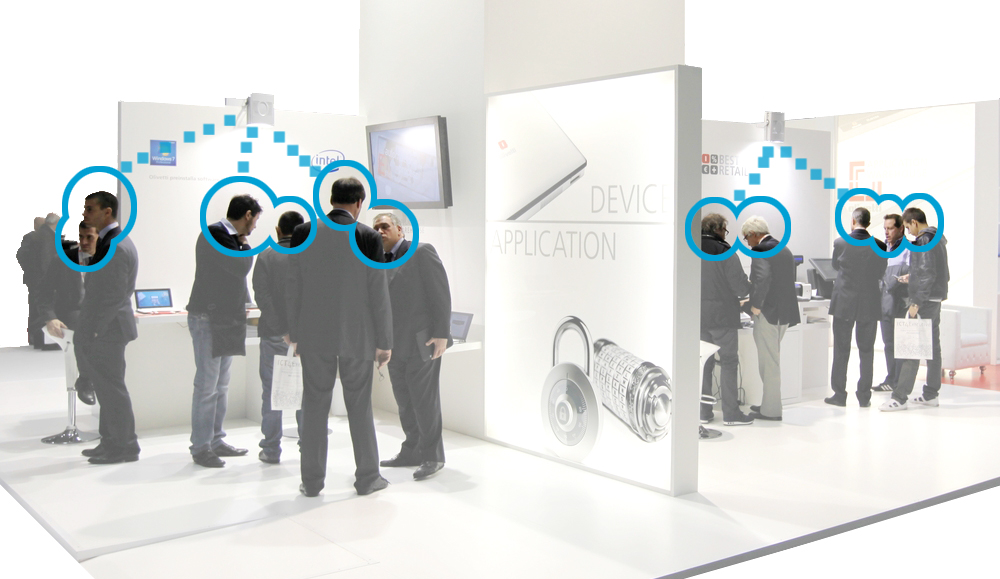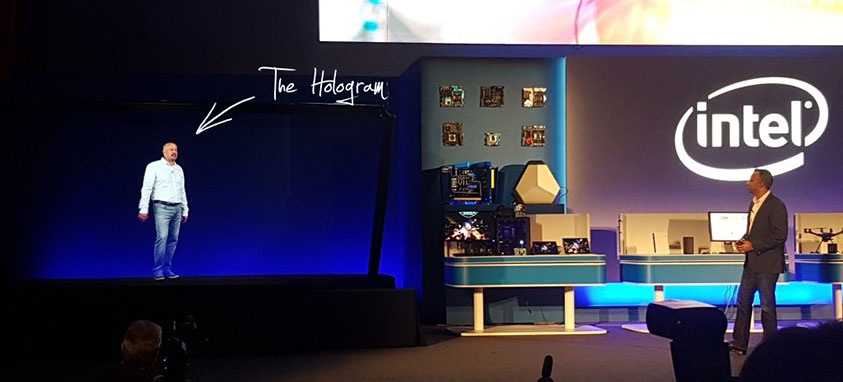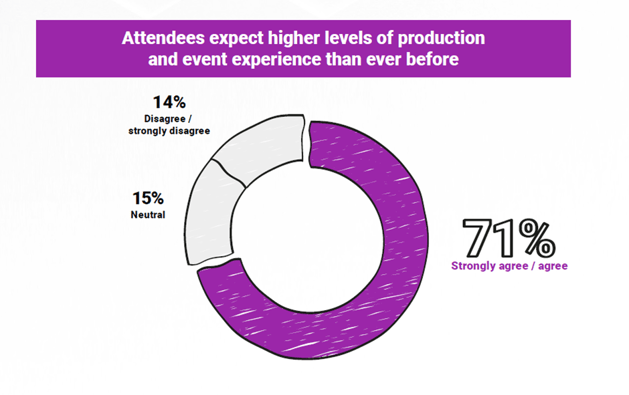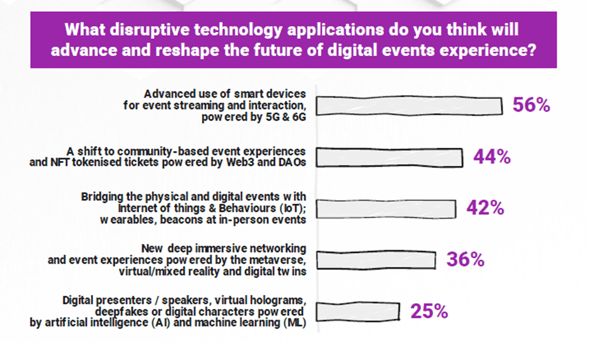Okay, don't expect laser beams and spaceships in this article. Though if you have the budget, I'm sure a few sci-fi elements would impress your guests immensely.
But the tools on this list are still pretty darn future-forward. We're talking AI, virtual presenters, and even the metaverse. But no lightsabers. Sorry.
But here's something out-of-this-world: the global virtual events market was valued at a whopping $114.12bn in 2021. That's a lot of zeros! And to make things even more interesting, it's predicted to grow at a compound annual growth rate of 21.4% between 2022 to 2030.
Check out our collab with Jugo, to find out more fun facts like these. Get your hands on our recent research report, The State of B2B Digital Event Experience, produced in association with Jugo. Plus, you can also download a US version of the report here!
The shift towards digitalisation has been so rapid that the events world is definitely feeling the impact. It seems like every organisation is investing in virtual event technologies and solutions, and trying to keep up with the times. But who can blame them? With the way things are going, it's either adapt or die!
Basically, attendees expect higher levels of production and experience than ever. So, CMOs have to keep up.
Marketers and event managers need to stay on top of the latest trends and technologies shaping the future of digital event experiences.
From 3D and virtual reality to gamification, there are so many new and innovative ways to create immersive and engaging events that leave attendees wanting more. I mean, who wouldn't want to attend an event where they can be transported to another world through the power of technology?
And speaking of technology, disruptive technology applications are likely to transform B2B digital event experiences in the coming years, creating more immersive, personalised, and engaging environments for attendees.
So, what's the future of digital event experiences? According to CMOs, it's all about deep immersive engagement through VR, digital twins, metaverse, and digital speakers/presenters powered by AI and ML. And who knows, with the way things are going, we might even be attending events through our VR headsets in the near future. Now, let's jump in.
Advanced Use of Smart Devices for Event Streaming and Interaction, Powered by 5G and 6G
With 5G's enhanced data transfer rate, we can download huge files or stream high-quality video content almost instantaneously.
This technology also supports massive machine-type communication, allowing a device to communicate with multiple other devices simultaneously, reducing overall network latency significantly.
The possibilities are endless with this robust network, revolutionising how we live each day. Additionally, 5G networks have a greater capacity than 4G networks, allowing more devices to connect simultaneously, and making it possible to support more users and devices in crowded areas, such as stadiums or city centres.
But that's not all! 6G will take things to a whole new level with higher performance that's far better than newly deployed 5G wireless networks.
With a peak data rate of 1,000 gigabits/s and air latency of fewer than 100 microseconds, 6G will operate at terahertz frequency bands, offering enhanced reliability and wider network coverage. When we talk about 5G vs 6G network speed, 6G speed is expected to be 100 times faster than 5G. Imagine the possibilities!
A Shift to Community-Based Event Experiences and NFT Tokenised Tickets Powered by Web3 and DAOs
The world of Web3 content creation has shown us how tokenization can enhance loyalty programming.
By using tokens to bootstrap projects and build a community of loyal, engaged fans who can access premium content and interact with fellow fans and creators, content creators have been able to build stronger relationships with their audience.
In a loyalty setting, branded fungible and nonfungible tokens on the blockchain could replace or complement traditional points and tier-based loyalty management solutions. These tokens can be used to gamify interactions, track engagement with the brand, and reward loyalty with real-world perks and benefits.

Tokens could also open creative avenues for businesses to plug in partners and merchants more easily, with interoperability rules programmed in. Smart contracts can automate much of the manual overhead that goes into managing liabilities and settling cross-partner points. The possibilities are endless with this innovative technology.
Bridging the Physical and Digital Events with the Internet of Things and Behaviours: Wearables, Beacons at In-person Events
One of the most exciting tech tools at your disposal is the Internet of Things (IoT). By leveraging these devices in a growing connected ecosystem, you can make your events more efficient, safe, and innovative.
Devices in the IoT can be used to sell and scan tickets, and smartphones are among the most common items in the IoT.
You can produce and issue tickets via one of the multiple apps currently on the market, using a quick-response (QR) code. Beacon technologies, small digital "lighthouses" sending out signals interacting with mobile phone apps, are making headway for events.
Beacon technology is a form of proximity marketing that sends marketing messages to people based on their location. In retail marketing, many big brands use this technology to send customers personalized offers when they shop in-store. At live events, beacons have a wide range of potential uses.

New Deep Immersive Networking and Events Experience Powered by the Metaverse, Virtual/Missed Reality, and Digital Twins
In today's rapidly evolving technological landscape, the latest trends in social shopping have transformed the way we make purchasing decisions.
The integration of augmented reality (AR) lenses into shopping apps and platforms has opened up a whole new world of possibilities for consumers. For instance, one can use AR lenses to try on different eyeglass frames or shades of lipstick, all from the comfort of their own home.
Using the selfie mode on your phone, you can now see how you would look in different frames or shades without ever having to leave your house. This technology has revolutionised the way we shop, making it more convenient and efficient than ever before.
But the application of AR technology in retail doesn't end there. Retailers have been exploring the use of 3D visualizations of their products that can be viewed from angle to angle.
This means that consumers can get a more immersive experience when shopping online, almost as if they were in a physical store. With the help of these 3D models, customers can see how a product looks from all angles, allowing them to make more informed decisions about their purchases.
Now imagine applying these technologies to events. At any stall, companies can demonstrate their products or services in an immersive and comprehensive way. But specifically for digital experiences, customers will be able to interact with products immediately and intensely.
With the rise of AR and 3D technology, it's now possible to take virtual conferences to the next level. Instead of simply seeing a person on a screen, you could be sitting at one large virtual conference table, side by side with executives from all over the globe. Each executive could be represented by their own avatar, giving the impression of a real-life meeting. This technology has the potential to make remote work more engaging and immersive, as well as more efficient and productive.
Digital presenters/speakers, virtual holograms, deep fakes or digital characters powered by artificial intelligence (AI) and machine learning (ML)
Artificial intelligence (AI) and machine learning (ML) power a range of digital presenters and speakers, including virtual holograms, deep fakes, and digital characters.
A hologram virtual presenter, also known as a hologram person or virtual mannequin, uses pre-recorded films to communicate messages in a compelling and reliable way. This technology can be used to promote products and services in various settings, including sales events, airports, conference centres, and building entrances.

One startup, Matsuko, is pushing the boundaries of holographic technology by creating a real-time hologram-meeting app that simulates in-person conversations using 3D holograms. With the pandemic accelerating the shift towards virtual presentations, there has been a surge of interest in holographic technology.
Major events, such as high-profile concerts and the London Olympics' Closing Ceremony in 2012, have showcased the potential of holograms, leading to increased innovation in the field by companies and startups, including Google and Microsoft.
Check out our collab with Jugo, to find out more fun facts like these. Get your hands on our recent research report, The State of B2B Digital Event Experience, produced in association with Jugo. Plus, you can also download a US version of the report here

